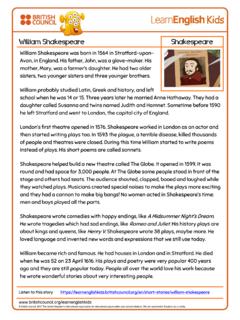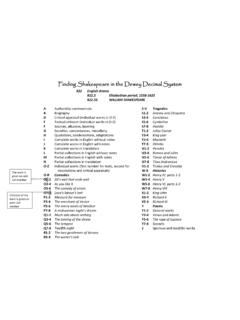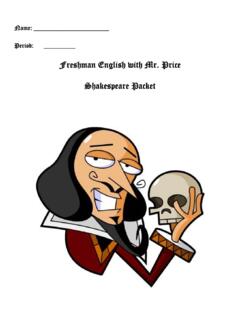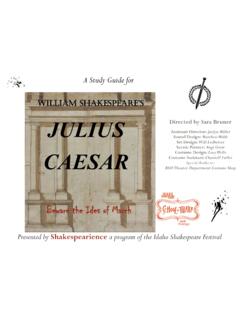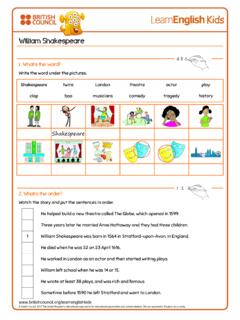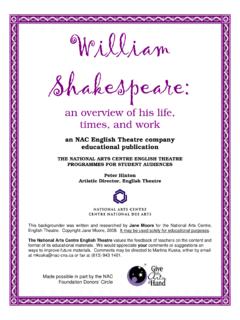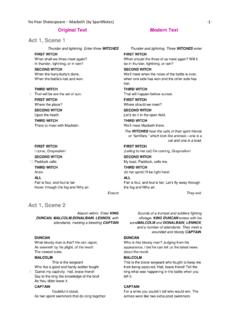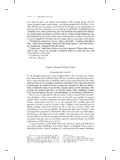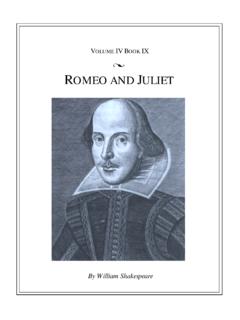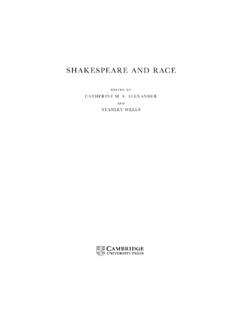Transcription of Shakespeare and Marriage: An Open Question
1 Literature Compass 8/9 (2011): 620 634, Shakespeare and marriage : An open Question Frances E. Dolan*. University of California, Davis Abstract marriage is a focus of conflict today, from lamentations about divorce rates to legal contests over same-sex marriage . It was equally contested in Shakespeare 's England, even if the issues at stake were somewhat different. Recent scholarship on the history of marriage has unsettled many of the assumptions that once governed discussions of early modern marriage and its representation on the stage. It is no longer safe to assume we know what early modern marriage meant, how it felt, or what it achieved or required.
2 This essay focuses particularly on new research on rates of marriage in early modern England, on married women's agency, will, and work, and on same-sex attach- ments. What are the implications of these new approaches for our readings of Shakespeare 's plays? Is marriage a happy ending? Is it an ending at all? Shakespeare and marriage ' seems at first a dispiritingly familiar conjunction of topics. For centuries now, biographers have speculated about Shakespeare 's own marriage , literary critics have turned to the history of marriage in an effort to make sense of the puzzling details and mixed messages about marriage one finds in the plays, and historians have looked to the plays for evidence regarding early modern marriage , or the timelessness of love, or the limitations of literature as historical evidence.
3 Peter Laslett epitomizes that last approach in his assertion that it is not true' that English women in Shakespeare 's day'. married in their early teens as several of Shakespeare 's heroines (most notably Juliet and Miranda) do (81). Even in Laslett's stern phrasing, the relationship between marriage in Shakespeare 's day and in Shakespeare 's plays is not self-evident. For example, Katherine's last speech detailing the gendered division of spousal temper- ament and labor in The Taming of the Shrew has been quoted as proof of the centrality of reciprocity and shared responsibility in long-standing Anglo-American ideals of marriage (Cott 12 3; Hartog 155 6; Underdown 117); it has also been read as articulating values that were, in the 16th century, either obviously anachronistic or boldly new (Boose 184.)
4 Korda 52 75). It can be viewed as moving testimony to an enduring vision of married love or as stomach-churning proof of the gender inequities of a former era. The play as a whole can be read as evidence of the persistence of English patriarchy as an aspiration and fantasy and of its internal contradictions and robust contestation; of the acceptance or censure of domestic violence; of changing or persistent spousal roles; of the enormous effort the model of male headship in marriage required and its dependence on wives to say as I say'; of the rewards women might secure through performative submission or the costs they might pay for peace, and love and quiet life; of violent subordination or of erotic and verbal mutuality.
5 The play bears out all of the above contentions, suggesting that they are all viable ways of thinking about marriage in the early modern period, all available in the play itself. Much of the play's action focuses on that uncertain phase between the wedding and the consummation when the terms of the marriage are being negotiated and the spouses are not quite joined yet. The fact that one might make a bet 2011 The Author Literature Compass 2011 Blackwell Publishing Ltd Shakespeare and marriage 621. regarding the nature of the relationship between spouses, and everyone involved might view the outcome as unpredictable, gives us a sense that the only common knowledge about marriage was that it did not guarantee anything.
6 As obsolete as the notion of shrew-taming might seem, the play opens up issues that remain under debate about what marriage means, what it requires of participants, what it makes possible or impossible, what costs it exacts and who has to pay them. The relationship of Shakespeare to marriage is not only a matter of historically situating Shakespeare 's works, or marriage , or both. The frequent recourse to Shakespeare for readings at weddings is a reminder that, however we understand the union of Shake- speare and marriage ', neither term is lodged safely in the past. Shakespeare remains a resource for imagining and expressing our expectations of marriage today.
7 In looking again at the topic of Shakespeare and marriage , it is necessary to, at once, surrender what we thought we knew, embrace new knowledge, and ask new questions. We must also accept how much we'll never know about the experience of early modern marriage . Much is inaccessible to us not only because of the passage of time but also because other people's intimate lives are always shrouded in mystery. Recent scholarship on the history of marriage has unsettled many of the assumptions that once governed discussions of early modern marriage and its representation on the stage. Many scholars have located dramatic changes in the motives for and meanings of marriage in the 16th and 17th centuries.
8 It has been variously argued that marriage moved from a sacrament to a contract, from a practical arrangement to regulate sexuality and to provide for children to a loving bond between companions, from a second-class alternative to clerical celibacy in line with the Pauline concession that it is better to marry than to burn' to an honorable, indeed, preferable way of life. Lawrence Stone made the boldest and most contested arguments about dramatic changes in early modern marriage , arguing, for instance, that a new emphasis on marital companionship and romantic love began in the upper classes and trickled down to the lower orders.
9 Many early challenges to Stone's hypotheses emphasized continuity rather than change (Houlbrooke; Macfarlane).1 Increas- ingly, discussion of early modern marriage focuses on the coexistence of continuity and change, what Keith Wrightson describes as enduring structures' and uneven' processes of change (12 3). New values jockeyed against old ones. Different people had different motives for marrying or not marrying; one marriage differed from another; any given per- son might have mixed feelings and mixed motives. Men and women married for a wide range of reasons. They might marry for financial gain or security from running a shop or farm together to uniting vast estates or to secure alliances from forging bonds with friends and allies at a local level to dynastic marriages.
10 They might marry largely to please other people or driven by their own need or want. They might marry to have intercourse and legitimate offspring, to achieve adult status, or to avoid loneliness and secure compan- ionship. Most would probably have more than one motive. Motives for a first marriage might differ from those for a second. Many probably chose a spouse based on attraction and affection, as well as practical considerations such as shared faith. Romantic love was neither new, nor irrelevant, nor an inevitable part of making and sustaining marriages. It was sometimes important to some people. It used to be assumed that marriage was inevitable, not only for the heroines of Shake- speare's comedies, but for women in early modern England.
